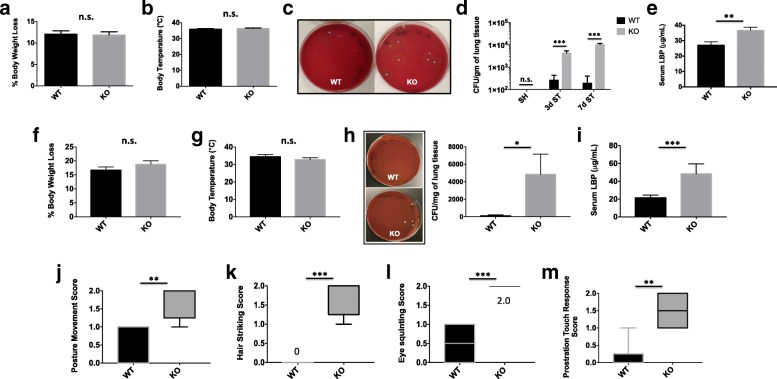Fig. 6.
CD200R1-deficient mice exhibit greater spontaneous bacterial colonization of the lung after stroke and enhanced sickness behavior in a LPS model of systemic immune challenge. CD200R1-mediated susceptibility to spontaneous bacterial infection was addressed after MCAO and in a second model of LPS-induced systemic immune challenge. The percentage of body weight loss (a) and core body temperature (b) is shown at day 3 after stroke is shown (N = 9/group). Representative images of bacterial colonies grown from lung homogenates on blood agar plates following acute stroke are shown (c). Lung colony-forming units (CFU) counts were statistically higher at days 3 and 7 in injured CD200R1-KO mice compared to CD200R1-WT control littermates (d). Serum concentrations of lipopolysaccharide-binding protein (LBP) at day 3 after stroke are shown (e). Percentage body weight loss (f) and body temperature (g) were quantified at day 3 after i.p. LPS injection (N = 6/group). Bacterial colonies cultured on blood agar demonstrated statistically higher lung colony-forming units (CFU) counts in injured CD200R1-KO mice compared to CD200R1-WT control littermates after endotoxin challenge (h; N = 6/group). Serum concentrations of lipopolysaccharide-binding protein (LBP) at day 3 after stroke are shown (i). Sickness behaviors were examined in CD200R1-knockout (KO) and wild-type (WT) control littermates 3 days after systemic LPS administration. CD200R1-KO mice had significantly worse sickness scores for postural movement (j), hair striking (k), eye squinting (l), and prostration touch response (m). For all behavioral experiments, N = 6/group. Error bars show mean SEM. SH sham, ST stroke, KO knockout, WT wild-type, SEM standard error of mean. *p < 0.05; **p < 0.01; ***p < 0.001

